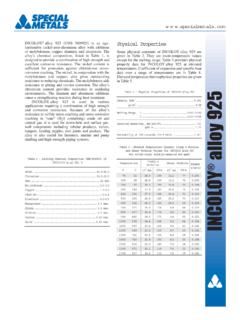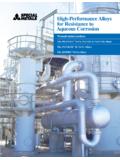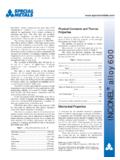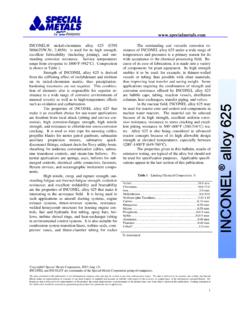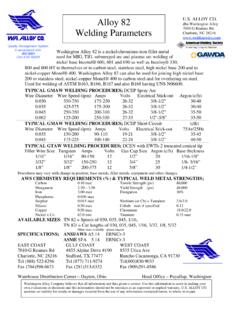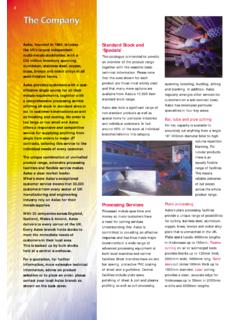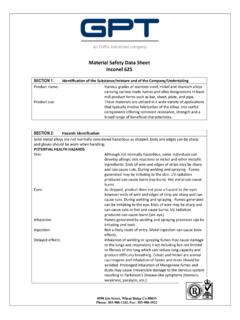Transcription of www.specialmetals
1 inconel nickel-chromium alloy 625 (UNSN06625 ) is used for its high strength,excellent fabricability (including joining), and outstand-ing corrosion resistance. Service temperatures rangefrom cryogenic to 1800 F (982 C). Composition isshown in Table of inconel alloy 625 is derived from thestiffening effect of molybdenum and niobium on itsnickel-chromium matrix; thus precipitation-hardeningtreatments are not required. This combination of ele-ments also is responsible for superior resistance to awide range of corrosive environments of unusual sever-ity as well as to high-temperature effects such as oxida-tion and carburization. The properties of inconel alloy 625 that make it anexcellent choice for sea-water applications are freedomfrom local attack (pitting and crevice corrosion), highcorrosion-fatigue strength, high tensile strength, andresistance to chloride-ion stress-corrosion cracking.
2 It isused as wire rope for mooring cables, propeller bladesfor motor patrol gunboats, submarine auxiliary propul-sion motors, submarine quick-disconnect fittings,exhaust ducts for Navy utility boats, sheathing forundersea communication cables, submarine transducercontrols, and steam-line bellows. Potential applicationsare springs, seals, bellows for submerged controls, elec-trical cable connectors, fasteners, flexure devices, andoceanographic instrument tensile, creep, and rupture strength; outstandingfatigue and thermal-fatigue strength; oxidation resist-ance; and excellent weldability and brazeability are theproperties of inconel alloy 625 that make it interest-ing to the aerospace field. It is being used in such appli-cations as aircraft ducting systems, engine exhaust sys-tems, thrust-reverser systems, resistance-welded honey-comb structures for housing engine controls, fuel andhydraulic line tubing, spray bars, bellows, turbineshroud rings, and heat-exchanger tubing in environmen-tal control systems.
3 It is also suitable for combustionsystem transition liners, turbine seals, compressorINCONEL alloy 625 TTaabbllee 11 - Limiting Chemical Composition, %aIf , and thrust-chamber tubing for rocket outstanding and versatile corrosion resistance ofINCONEL alloy 625 under a wide range of tempera-tures and pressures is a primary reason for its wideacceptance in the chemical processing field. Because ofits ease of fabrication, it is made into a variety of com-ponents for plant equipment. Its high strength enables itto be used, for example, in thinner-walled vessels ortubing than possible with other materials, thus improv-ing heat transfer and saving weight. Some applicationsrequiring the combination of strength and corrosionresistance offered by inconel alloy 625 are bubblecaps, tubing, reaction vessels, distillation columns, heatexchangers, transfer piping, and the nuclear field, inconel alloy 625 may be usedfor reactor-core and control-rod components in nuclearwater reactors.
4 The material can be selected because ofits high strength, excellent uniform corrosion resistance,resistance to stress cracking and excellent pitting resist-ance in 500 -600 F (260-316 C) water. Alloy 625 isalso being considered in advanced reactor conceptsbecause of its high allowable design strength at elevat-ed temperatures, especially between 1200 -1400 F(649-760 C).The properties given in this bulletin, results of exten-sive testing, are typical of the alloy but should not beused for specification purposes. Applicable specifica-tions appear in the last section of this publication. Publication Number SMC-063 Copyright Special Metals Corporation, 2006 (Jan 06) inconel and INCOLOY are trademarks of the Special Metals Corporation group of data contained in this publication is for informational purposes only and may be revised at any time without prior notice.
5 The data is believed to be accurate andreliable, but Special Metals makes no representation or warranty of any kind (express or implied) and assumes no liability with respect to the accuracy or complete-ness of the information contained herein. Although the data is believed to be representative of the product, the actual characteristics or performance of the productmay vary from what is shown in this publication. Nothing contained in this publication should be construed as guaranteeing the product for a particular use or (plus Tantalum).. , lb/cu Range, Heata,Btu/lb F (J/kg C)0 F (-18 C).. (402)70 F (21 C).. (410)200 F (93 C).. (427)400 F (204 C).. (456)600 F (316 C).. (481)800 F (427 C).. (511)1000 F (538 C).. (536)1200 F (649 C).. (565)1400 F (760 C).. (590)1600 F (871 C).. (620)1800 F (982 C).. (645)2000 F (1093 C).. (670)Permeability at 200 Oersted ( kA/m).
6 Curie Temperature, <-320 22 - Physical ConstantsaCalculated aFrom 70 Fto temperature shown bMeasurements made at Battelle Memorial Institute cMaterial annealed 2100 F/1 of expansion, Fx10-6 Temperature, FFFiigguurree Thermal Expansion at Low TemperaturesIINNCCOONNEELL aallllooyy 6622552 PPhhyyssiiccaall CCoonnssttaannttss aanndd TThheerrmmaall PPrrooppeerrttiieessSome physical constants and thermal properties ofINCONEL alloy 625 are shown in Tables 2 and 3. Low-tem-perature thermal expansion, based on measurements madeby the National Bureau of Standards, is shown in Figure modulus of elasticity data are given inTable FFMM eeaann LLiinneeaarrEExxppaannssiioonnaa1100--66 iinn//iinn FFTT hheerrmmaallCCoonndduuccttiivviittyybb,, ccBBttuu iinn//fftt22--hh FFEE lleeccttrriiccaallRReessiissttiivviittyy ccoohhmm--cciirrcc mmiill//ffttTTeemmppeerraattuurree CCTT hheerrmmaallCCoonndduuccttiivviittyybb,, ccWW//mm CCEE lleeccttrriiccaallRReessiissttiivviittyy cc --ccmmTTaabbllee 33- Thermal and Electrical PropertiesTemperature, of expansion.
7 M/ C14-240 -184 -129 -73 -18 381113 MMeeaann LLiinneeaarrEExxppaannssiioonnaa mm// mm CC-250 50 -157 -200 52 -129 -100 58 -73 0 64 -18 70 6877621 7078038 1800 175812982 8061093 134 MMeecchhaanniiccaall PPrrooppeerrttiieessNominal room-temperature mechanical properties ofINCONEL alloy 625 are shown in Table service at 1200 F and below, hot-finished, cold-fin-ished, and annealed conditions (depending on requirementsinvolved) are service above 1200 F, either annealed or solution-treated material will give best service. The solution-treatedcondition is recommended for components that require opti-mum resistance to creep or rupture. Fine-grained (annealed)material may be advantageous at temperatures up to 1500 Fwith respect to fatigue strength, hardness, and tensile andyield s two-load was used for determination of thetrue stress-strain curve for alloy 625 at room two-load test requires no strain measurement during thetest, and only the maximum and fracture loads are for both annealed and solution-treated material areshown in Figure 55 -- Nominal Room-Temperature Mechanical PropertiesaaValues shown are composites for various product sizes up to 4 in.
8 They are not suitable for specification purposes. For properties of larger-sized products,consult Special Metals stress-true strain of Strain, Stress, ksiCold-Drawn AnnealedHot-RolledSolution-TreatedIINNCC OONNEELL aallllooyy FFAA nnnneeaalleeddSSoolluuttiioonn--TTrreeaa tteeddAAnnnneeaalleeddSSoolluuttiioonn-- TTrreeaatteeddAAnnnneeaalleeddSSoolluutt iioonn--TTrreeaatteeddTTaabbllee 44- Modulus at Elevated TemperaturesaTTeennssiioonnMMoodduulluus s ooff EEllaassttiicciittyy,, 110033kkssiiSShheeaarrPPooiissssoonn CCAA nnnneeaalleeddSSoolluuttiioonn--TTrreeaa tteeddAAnnnneeaalleeddSSoolluuttiioonn-- TTrreeaatteeddTTeennssiioonnMMoodduulluu ss ooff EEllaassttiicciittyy,, GGPPaaSShheeaarra Determined dynamically on samples from -in. hot-rolled 2758 True Stress, MPaFFoorrmmaanndd CCoonnddiittiioonnRReedduuccttiioonn ooff AArreeaa%%HHaarrddnneessss,,BBrriinneell llROD, BAR, PLATE As-RolledAnnealedSolution-TreatedSHEET and STRIPA nnealedTUBE and PIPE,COLD-DRAWNA nnealed Solution-Treated175-240145-220116-194145 -240 TTeennssiilleeSSttrreennggtthhYYiieelldd SSttrreennggtthh(( OOffffsseett))kkssii MMPP aakkssii MMPPaa60-4060-4090-60 EElloonnggaattiioonn%%120-160120-150105- 130120-150120-140100-120827-1103827-1034 724-896827-1034827-965689-82760-11060-95 42-6060-9060-7540-60414-758414-655290-41 4414-621414-517276-41460-3060-3065-4055- 3055-3060-4010938716494272040 TTaabbllee 66 - Effect of Intermediate-Temperature Exposure (2000 hr)
9 On Properties of Hot-Rolled Annealed BarTTeennssiillee PPrrooppeerrttiieess aanndd HHaarrddnneessssTypical tensile properties of annealed and solution-treatedmaterial from room to elevated temperature are shown inFigures 3, 4, and 5. The approximate relationship betweenthe hardness and tensile and yield strength of strip is shownin Figure 6. Increased tensile properties for service at moderate tem-perature can be achieved by cold work. See the section, Working Instructions for some specific exposure to intermediate temperatures, some hard-ening takes place in alloy 625. To demonstrate this reaction,samples of annealed rod were exposed at 1200 , 1400 , and1600 F for 2000 hr. The effect of exposure on propertiesboth at room temperature and at exposure temperature isshown in Table 6. Measurements were made to determinedimensional stability; the samples exposed at 1200 to1400 F for 2000 hr contracted about StrengthYield Strength ( Offset)ElongationTemperature, FFFiigguurree tensile properties of annealed , ksi Elongation, %2000160012008004000140120100806040200 IINNCCOONNEELL aallllooyy 662255aValues shown are composites for various product sizes up to 4 in.
10 They are not suitable for specification purposes. For properties of larger-sized products,consult Special Metals , CStress, MPa Elongation, %EExxppoossuurree TTeemmppeerraattuurree,, FF (( CC))No Exposure1200 (649)1400 (760)1600 (871)PPrrooppeerrttiieess aatt RRoooomm TTeemmppeerraattuurreeYYiieelldd SSttrreennggtthh(( ooffffsseett))kkssii MMPPaaTTeennssiillee SSttrreennggtthhkkssii MMPPaaPPrrooppeerrttiieess aatt EExxppoossuurree TTeemmppeerraattuurreeEElloonnggaattiioo nn,,%%YYiieelldd SSttrreennggtthh(( ooffffsseett))kkssii MMPPaaTTeennssiillee SSttrreennggtthhkkssii MMPPaaEElloonnggaattiioonn,,%% , FStress, ksi Elongation, %FFiigguurree tensile properties of cold-rolledannealed StrengthElongationYield Strength( Offset)Temperature, FStress, ksiElongation, %Tensile StrengthElongationYield Strength( Offset)

